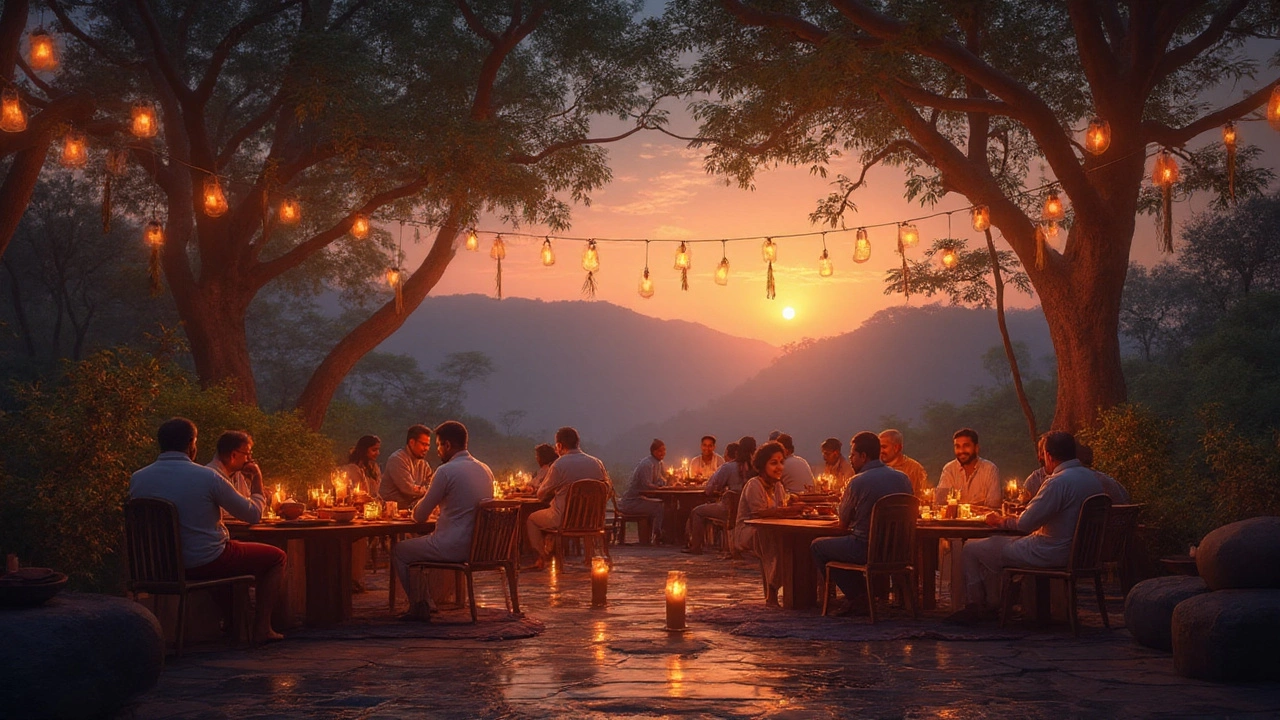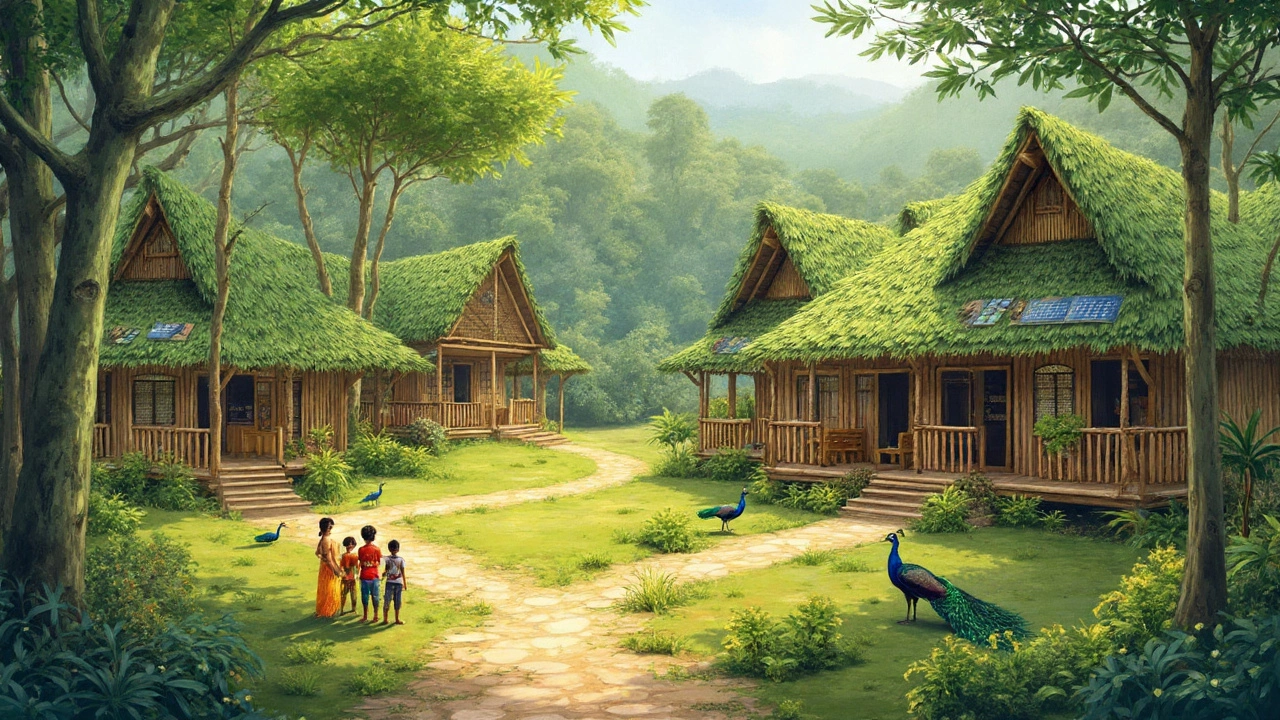Picture this: waking up in a rainforest, birds singing out the window, drinking coffee brewed with rainwater, and knowing every choice the resort makes—big or small—helps the planet. That’s not some new-age fantasy. Eco-friendly resorts are popping up everywhere and they’re shaking up the way people think about travel.
What Does “Eco-Friendly Resort” Really Mean?
Eco-friendly resorts are more than hotels with a recycling bin by the elevator. They commit, in a real, sometimes radical way, to lightening their environmental impact. It’s not just about "not wasting electricity." Imagine entire roofs made from native grass, solar panels powering Wi-Fi, or even swimming pools that use saltwater instead of endless chemicals. That’s the level of detail these places go for. The core idea: people enjoy modern comforts, but not at nature’s expense.
Owners of these resorts map out every decision, from the architecture to the laundry detergent. The buildings are often set up to let in natural light and keep things cool without blasting the air-con. Materials are usually local—think bamboo huts in Bali or recycled timber cabins in Costa Rica—cutting carbon miles and keeping the vibe authentic. It’s rare to find single-use plastics, and even rarer to see anyone tossing waste left and right.
But there’s a human side here too. Many resorts train, hire, and promote staff from the community next door rather than flying in specialists from miles away. This keeps the money local and the soul authentic—so when you order a classic dish, the chef learned it from their grandma, not YouTube.
The term “eco-friendly” isn’t regulated everywhere. Some places slap a green logo on their website but offer little substance. Yet, if you really dig in, the best eco resorts are proud to show their certifications—like LEED (Leadership in Energy and Environmental Design), Green Globe, or EarthCheck. Some even share annual sustainability reports, which, if you’re a curious traveler, make for surprisingly inspiring reading.
Eco resorts aren’t always remote hideaways. Some are in the heart of the city, proving it’s possible to create a green oasis anywhere. Green rooftops, solar parking canopies, urban gardens for the restaurant—urban eco-friendly resorts get creative to shrink their footprint. Whether city or jungle, the common thread is chasing comfort, style, and planet-friendly impact all at once.
But here’s the simple truth: calling something ‘eco-friendly’ is a commitment. It’s about making choices every day that matter, usually in ways the guest may never notice but will always feel. Places that get it right can transform travel from a guilty pleasure to something genuinely good for the world.
Sustainable Design: How the Best Resorts Build with Nature
If you hang around in eco-resorts long enough, you start to notice something—these places don’t fight their setting, they blend in. Sustainable design might sound like industry jargon, but it really just means the buildings and landscaping fit the land like a well-worn shoe. A few years ago, a study from the World Green Building Council said that sustainable buildings can slash carbon emissions by up to 30%. That’s huge when you consider how much resorts usually consume.
The design of these spaces borrows heavily from the natural world. Striking views are part of the package—but so is weather. Resorts might tuck rooms below the tree line to protect from sun and storms or use overhangs that shade windows but let the summer breeze roll through. Walls can be thick, made from earth or stone, and always stuck on the idea of regulating body temperature naturally: warm in winter, cool in summer.
- Solar panels and wind turbines for electricity—there’s a good chance your morning smoothie was whirred up on power harvested from yesterday’s sunlight.
- Rainwater harvesting systems for showers and gardens. If you spot barrel-shaped tanks at the back, that’s what they’re doing.
- Greywater recycling means used sink and shower water gets filtered and diverted to water the flowers or flush the toilets.
- Compost toilets, which smell way better than you’d think, replace mechanical flushers to save tons of water every year.
- The resort might use natural materials from the area—they’ll point to the timber in the lobby or the thatching up top, maybe adding, “We replanted twice what we harvested.”
Take Soneva Fushi in the Maldives, for example. This place harvests the sun for its power, reuses all organic waste in its gardens, and even filters and bottles its own drinking water, cutting out single-use plastic bottles completely. If you ever get to Brisbane’s Crystalbrook Collection, you’ll see designs that let sunlight flood in but shuffle heat out, using a clever mix of art and engineering. This isn’t DIY hippie stuff—it’s high-end, tech-meets-tradition innovation.
You might be wondering how all this impacts travelers. Well, for starters, resorts that stay cool naturally don’t rack up monster energy bills, which means the planet pays less, and often, so do you. If you wander the grounds, you’ll see natural landscaping—native plants, not imported palm trees guzzling gallons of water. These design choices attract not only eco-nerds but regular people who notice, “Wow, it feels good here.”
Sustainable design isn’t a fad. It’s a way forward in an industry that used to treat the land like a blank slate. Now, the smartest places ask the land what it needs first—and then build with respect.

Beyond Solar Panels: Daily Practices That Make Respects Actually Green
If you visit an eco-friendly resort, you’ll probably spot some solar panels and energy-saving bulbs. But being green isn’t only about the big stuff. It’s how staff run things every day that makes the system work. You’ll probably never see the compost bin behind the kitchen, but it’s there—turning veggie scraps into garden booster. Or the clever setups that let every towel and linen dry under the sun instead of using industrial dryers all day.
Food’s another big deal. Many eco resorts flip the old “continental breakfast” on its head and work with locals to bring in what’s in season—bananas, tropical fruit, local coffee. If the kitchen grows its own herbs and veggies, even better. This cuts down shipping emissions and creates a menu that’s honestly tastier and fresher than food that’s been on a truck for days.
Water—really the biggest deal in lots of places—gets saved everywhere it can. Low-flow taps and showers, rainwater tanks, native gardens (because who needs a thirsty lawn in the outback?), and zero single-use plastic bottles anywhere. Instead, expect filtered water in reusable glass or stainless bottles. Tangaroa Blue—a legit organization here in Australia—estimates that swapping reusable bottles for plastic can keep tens of thousands of bottles from ending up in creeks and oceans every year, even at just one resort.
Waste gets sorted. You’ll find bins marked for compost, recyclables, soft plastics, or landfill. Staff might even show guests how to sort stuff right—a hands-on way to make travelers aware of their own daily habits. Laundry happens only when actually needed (when’s the last time you changed your towel at home every single day?).
Transport—another biggie. Many eco resorts run electric buggies, bicycles for guest use, and even encourage walking trails rather than carving up forests for roads. Sometimes they even pitch in with local wildlife rescues or beach cleanups. Guests can join if they want, offering a zero-pressure way to feel like part of a bigger mission during their downtime.
The best daily practices make sustainability easy, not a guilt trip. No angry lectures here—just lots of smart nudges and simple systems, all built so anyone, from kids to grandparents, can pitch in and make a difference during their holiday.
Guest Experience: What It’s Like to Stay at an Eco-Resort
Staying at an eco-friendly resort brings out more "wow" moments than most guests expect. These places aren’t about missing out—they’re about discovering just how good a vacation can feel when nothing’s wasted and the natural world feels all around you.
You’ll usually find rooms designed to invite the outside in. Think floor-to-ceiling windows, patios that open onto forest or sea, and not a strip mall in sight. That fresh feeling? It’s real—thanks to improved air quality, the scent of native woods, and even better sleep from blackout curtains or natural darkness (light pollution is a no-go here).
Food holds stories. A breakfast of bush honey and sourdough, or mangos picked that morning, tastes different—and you’re invited to ask about the farmers or fishermen who made it happen. Some resorts offer behind-the-scenes tours of their gardens or even let guests join a cooking class using nothing but local ingredients. Kids often get a kick out of feeding chickens or learning to plant herbs, and watching young ones like Ansel get muddy in a food garden beats screen time any day.
Activities don’t stop at the spa. There’s usually hiking, birdwatching, maybe kayaking in clear water instead of burning fuel on jet skis. Wildlife lovers might spy koalas, turtles, or in some places, even dolphins from the shore. Staff are usually local, friendly, and quick to share a story—reminding you this isn’t just a business, but a living part of the community.
There’s also a sense of belonging. A traveler might arrive feeling skeptical but leaves feeling part of a real mission. Guests swap tips about packing less plastic, or what local tour not to miss, and it rubs off. Children seem to absorb the eco-message without anyone nagging; adults leave with small habits that last long after the trip.
And the price? Not always wallet-crushing. While luxury eco retreats exist, the movement now includes affordable options, family cabins, and even hostels. Look out for clever partnerships or off-season packages, which make a green stay possible for regular people—not just a niche crowd.
Travelers today want memories, not just souvenirs. Eco resorts deliver those in spades, all while giving back to the world they depend on.

The Numbers Behind Eco-Friendly Resorts: Real Impact, Not Just Hype
You might wonder, "Is all this effort really making a dent?" Let’s talk stats. The World Tourism Organization reports that tourism is responsible for about 8% of global carbon emissions. Resorts—a big chunk of that—can change things, fast. Top eco resorts often cut their water use by 50% and waste sent to landfill by 60% or more, simply by changing everyday routines and investing in greener tech.
| Area of Impact | Standard Resort | Eco-Resort (Best Practice) |
|---|---|---|
| Water Use per Guest (Litres/Day) | 800 | 350 |
| Single-Use Plastics Used per Stay | 20+ | Zero or close to zero |
| Local Sourcing (% of Total Meals) | 10-20% | 60% or more |
| Waste Sent to Landfill | Up to 75kg/week | 30kg or less |
| Energy From Renewables | 5-10% | 45%+ |
Popular resorts broadcast these numbers. Not just for marketing, but for accountability—and to nudge others to catch up.
Some governments are now demanding change, too. In Australia, for example, Queensland’s Eco Tourism Certification sets out strict standards. Only resorts cutting waste, using local labor, and protecting native species get to wear that badge. The impact goes beyond the front gate; eco resorts typically inspire copycats among neighbors and even cities, proving that change is scalable.
If you’re picking where to book your next stay, look for certifications like EarthCheck, Rainforest Alliance, or Global Sustainable Tourism Council credentials. These are real—staff at certified places have to jump through lots of hoops and prove their commitment keeps going year after year.
But the real magic is personal. You leave knowing you helped—not just by using a bamboo toothbrush, but by showing that people want experiences that respect the environment. The demand for eco-friendly resort options is only going up. And the planet? She gets a holiday too.
